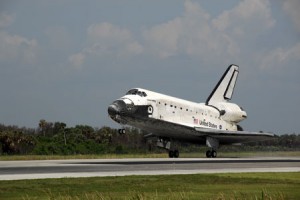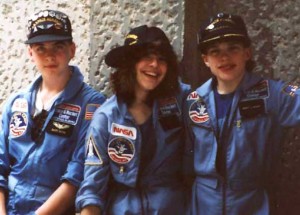 Earlier this morning the space Shuttle Discovery landed down in Florida. This particular mission carried the JAXA’s Japanese Experiment Module (“Kibo” which means hope), to the International Space Station. This new addition to the ISS brings with it new opportunities for both pressured and exposed-to-space experiments. This is the third research module, after Destiny (US, 2001) and Columbus (ESA, 2008). This little module adds significant scientific capacity to the station and also provides Japan with its first foothold in manned space. The next space shuttle launch, currently scheduled for October 2008, will be the final servicing mission for the Hubble Space Telescope
Earlier this morning the space Shuttle Discovery landed down in Florida. This particular mission carried the JAXA’s Japanese Experiment Module (“Kibo” which means hope), to the International Space Station. This new addition to the ISS brings with it new opportunities for both pressured and exposed-to-space experiments. This is the third research module, after Destiny (US, 2001) and Columbus (ESA, 2008). This little module adds significant scientific capacity to the station and also provides Japan with its first foothold in manned space. The next space shuttle launch, currently scheduled for October 2008, will be the final servicing mission for the Hubble Space Telescope
These two missions are of particular note because they are enabling science. While the Space Shuttle is a really good pickup truck, it fully capable of carrying more than just construction materials. It can also carry science labs and scientists into space. This science is good for a bunch of reasons.
First of all, while the ISS keeps politicians happy with its “Let’s all play nice together in space” way of bringing international astronauts together, this really doesn’t do much more than spend a lot of money in the name of goodwill. On the other hand, give those astronauts some science to do, and now you are producing knowledge and jobs for years to come. The samples that are created, the data that gets taken, and the critters that get raised in space will get analyzed over and over in new ways across generations of astronomers and geophysicists. The Apollo Lunar samples are still producing new results
The shuttle is running out of time – running out of launches – but it is using what little time it has to the fullest.
 For me, the end of the Shuttle program is a bittersweet thing. One of my earliest memories is living in California beneath the landing path of the shuttle, and running back and forth from the TV to the backyard to compare the contrails in the sky with the image on the TV. My first national tragedy, made more personal by my New England youth, was the destruction of the Space Shuttle Challenger on take off. My nerdy teenage years were punctuated by trips to Space Camp (I even had my first kiss while at Space Academy, just outside the astronaut training pool). I passed my teen years play acting at Space Shuttle commander and memorizing the launch and landing patterns of these large white winged birds. As a college student, I held my breath to see if the Servicing Mission cleaned up Hubble optics, and as a grad student I cheered on the early construction of the ISS. Perhaps my generation would have a place in space? And part of my first job at Astronomy Magazine had me covering the loss of the Space Shuttle Columbia. And today – Today I have a student covering the space shuttle launches for Astronomy Cast. (Picture of me and my two best friends in 8th grade at Space Camp)
For me, the end of the Shuttle program is a bittersweet thing. One of my earliest memories is living in California beneath the landing path of the shuttle, and running back and forth from the TV to the backyard to compare the contrails in the sky with the image on the TV. My first national tragedy, made more personal by my New England youth, was the destruction of the Space Shuttle Challenger on take off. My nerdy teenage years were punctuated by trips to Space Camp (I even had my first kiss while at Space Academy, just outside the astronaut training pool). I passed my teen years play acting at Space Shuttle commander and memorizing the launch and landing patterns of these large white winged birds. As a college student, I held my breath to see if the Servicing Mission cleaned up Hubble optics, and as a grad student I cheered on the early construction of the ISS. Perhaps my generation would have a place in space? And part of my first job at Astronomy Magazine had me covering the loss of the Space Shuttle Columbia. And today – Today I have a student covering the space shuttle launches for Astronomy Cast. (Picture of me and my two best friends in 8th grade at Space Camp)
At each stage in my life, I have been touched by the Space Shuttle, and in 2010, the only human conveyance into space the US has will go away. The vehicle I dreamed of flying in as a child will go away.
But until that last launch, at least the shuttle is spending some of its time motivating science.



Since the first plans of “Project Constellation” I’ve always found it funny that in movies we always see future spacecrafts as either plane like or more ship like (star trek/bsg).
Yet NASA seems to be heading to a system similar to the Apollo programs.
I’ve never had the joy of seeing a space shuttle launch or landing. I’ve never seen a rocket go up for that matter.
Closest I’ve been was to a part of a space shuttle that resides in the euro space center (if its still there, haven’t been there in quite a while).
Although I do remember as a kid i always wanted the blue trainer suite thingies (never got one though) and reading a horribly incorrect book about the space shuttle… till I found part of the training manual online… and gave up to the overly complexity.
As a kid growing up in the sixties, my passion was building Estes model rockets. A direct result of the Gemini and Apollo rockets I watched on TV taking man into space. My favorite was a model called “The Orbital Transport” It was a space plane than when it reached apogee, it would release a little glider that looked a lot like the modern day shuttle. I always thought it would be cool is the spacecraft of that day could look like that little shuttle glider.
Now turning 50, that dream came true and is now coming to an end. As did my childhood. That noose of time has us all.
Brian.
Yeah, I really loved model rockets also, and as a kid I was so exited about the shuttle I could’ve popped. I was convinced that a career on a space station or the moon was a real possibility for me.
But alas, world populations became self-regulating, and we found out space travel was both much more expensive and much less useful than we thought I really don’t know where manned spaceflight is going. It’s sad to think we could just abandon it entirely, as if it were just a phase that our species went through.
I too am a bit sad about the end of the shuttle era; however, I am worried about the future of space exploration in general. My Dad was an engineer on the Apollo 11 missions and he always spoke about the excitement of the space program and how it energized the nation and for that matter the world. Now, given the world in its current state of affairs, I am concerned that people will value less and less the need to continue to explore the universe and pursue man’s greatest adventures, seeing how the U.S. has engaged the largest deficit in history to pursue a ridiculous war. As my son and I build and launch model rockets, he often speaks about wanting to be an engineer and build and fly real rockets and spacecraft. I hope the day will come when man realizes his future can not be isolate to the planet he evolved upon and my son will live the dreams fired by his childhood and his imagination.
The Space Shuttle program is coming to an end, but we must look forward with great optimism. NASA had to go for a reusable vehicle back in the 1970s because people were complaining about the cost of sending men to the Moon. But we all knew that such a vehicle could never ferry astronauts and a lunar lander to the Moon. The Shuttle was just that – a vehicle to ferry people into low-Earth orbit, which is where the HST and the ISS are.
With Project Constellation excitement is building again. Who can ever forget the days of Apollo? They were fantastic. With Project Constellation and the Ares vehicles we are getting back to basics – where we left off in the 1970s. We need a Moonbase and we need to open up the solar system, starting with a manned bases on the Moon and Mars. As a species we are, and always have been, pioneers in search for new lands to colonize and make ours. That is the way we will flourish.
The past 40 years since Armstrong and Aldrin first set foot on the Moon have not been wasted. They have been truly successful beyond our wildest dreams. Our robot pioneers have shown us new worlds around the gas giants; they have crawled on the Martian surface; and one has landed on Titan, of all places! We learn and we plan ahead. Next stop Mars. We can build biomes there. We can turn the Martian sky blue because our robots have shown us where the water is. We have seeds and spores on Earth. We can plant them elsewhere.